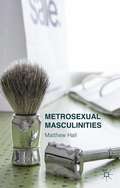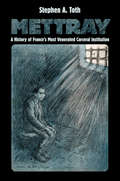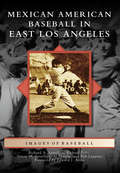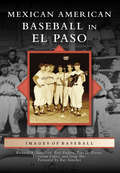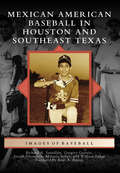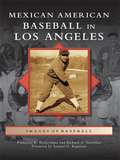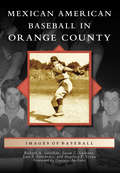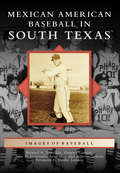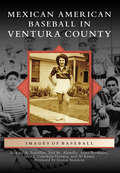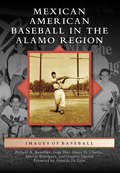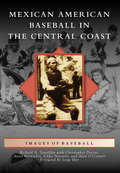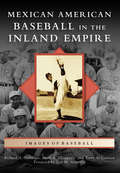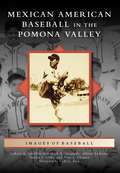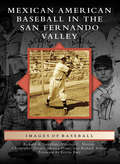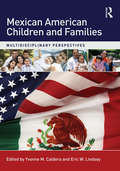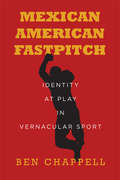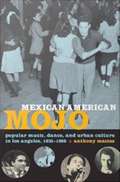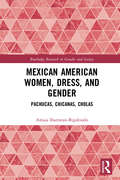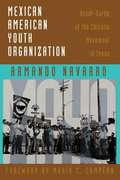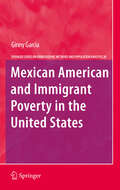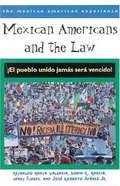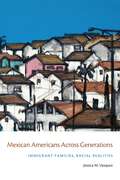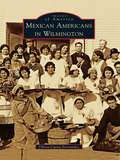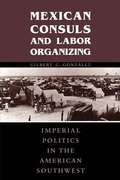- Table View
- List View
Metrosexual Masculinities
by Matthew HallModern men the world over are becoming increasingly fascinated with their image, spending more of their disposable income on beautification products and services. This book examines 'metrosexuality', highlighting the negotiation and construction of masculinities and sexualities in the twenty-first century.
Mettray: A History of France's Most Venerated Carceral Institution
by Stephen A. TothThe Mettray Penal Colony was a private reformatory without walls, established in France in 1840 for the rehabilitation of young male delinquents. Foucault linked its opening to the most significant change in the modern status of prisons and now, at last, Stephen Toth takes us behind the gates to show how the institution legitimized France's repression of criminal youth and added a unique layer to the nation's carceral system.Drawing on insights from sociology, criminology, critical theory, and social history, Stephen Toth dissects Mettray's social anatomy, exploring inmates' experiences. More than 17,000 young men passed through the reformatory before its closure, and Toth situates their struggles within changing conceptions of childhood and adolescence in modern France. Mettray demonstrates that the colony was an ill-conceived project marked by internal contradictions. Its social order was one of subjection and subversion, as officials struggled for order and inmates struggled for autonomy.Toth's formidable archival work exposes the nature of the relationships between, and among, prisoners and administrators. He explores the daily grind of existence: living conditions, discipline, labor, sex, and violence. Thus, he gives voice to the incarcerated, not simply to the incarcerators, whose ideas and agendas tend to dominate the historical record. Mettray is, above all else, a deeply personal illumination of life inside France's most venerated carceral institution.
Mevlevi Manuscripts, 1268–c. 1400: A Study of the Sources
by Cailah JacksonThis book provides a detailed and carefully researched catalogue of over 140 manuscripts related to the Mevlevi Sufis in their formative period during the thirteenth and fourteenth centuries. It also offers an in-depth and rigorous analysis of the manuscript material, which reveals much about the role of manuscripts in early Mevlevi life, the identity of disciples who were scribes and manuscript owners, and the geographical spread of the Sufi group. The Mevlevi Sufis were one of the most important and prominent socio-religious groups to emerge in late medieval Anatolia, following the Mongol conquests of the 1240s. Sometimes known colloquially as the ‘whirling dervishes,’ the Mevlevis became particularly powerful under Ottoman rule in the early modern period, even counting some sultans as their disciples. However, there is still much to learn about their earliest days, following the death of their ‘patron saint’ Jalal al-Din Rumi in 1273. Rumi is of course also notable as the authorof the Masnavi, an extensive work of Sufi poetry written in rhyming couplets that is the core of Mevlevi ritual and learning. Beyond Mevlevi circles, Rumi remains very popular today as a ‘mystic’ poet. This study sheds new light on the intellectual culture of his time.
Mexican American Baseball in East Los Angeles (Images of Baseball)
by Richard A. Santillán Al Padilla Bob Lagunas Richard Peña Teresa M. SantillánMexican American Baseball in East Los Angeles highlights the unforgettable teams, players, and coaches who graced the hallowed fields of East Los Angeles between 1917 and 2016 and brought immense joy and honor to their neighborhoods. Off the field, these players and their families helped create the multibillion-dollar wealth that depended on their backbreaking labor. More than a game, baseball and softball were political instruments designed to promote and empower civil, political, cultural, and gender rights, confronting head-on the reactionary forces of prejudice, intolerance, sexism, and xenophobia. A century later, baseball and softball are more popular than ever in East Los Angeles. Dedicated coaches still produce gifted players and future community leaders. These breathtaking photographs and heartfelt stories shed unparalleled light to the long and rich history of baseball and softball in the largest Mexican American community in the United States.
Mexican American Baseball in El Paso (Images of Baseball)
by Richard A. Santillan Donavan Lopez Eric Enders Pete G. FloresMexican American Baseball in El Paso chronicles the vibrant and colorful history of baseball in the El Paso–Juárez border region. For more than a century, baseball along the border has served as a means of bringing together people of all backgrounds, races, and nationalities, from the fly-by-night teams of the Pancho Villa era to the fabled semiprofessional clubs of the Lower Valley League. For the area’s Mexican and Mexican American citizens, storied teams like the Juárez Indios, Fabens Merchants, 1949 Bowie Bears, and El Paso Diablos served as both community rallying points and signposts of cultural identity. From the legendary semiprofessional players of decades past to the most recent major leaguers, this book presents the photographic history of baseball in America’s largest border community.
Mexican American Baseball in Houston and Southeast Texas (Images of Baseball)
by Richard A. Santillán Gregory Garrett Ramos Joseph Thompson Mikaela Selley William LangeMexican American Baseball in Houston and Southeast Texas pays tribute to the baseball and softball players and teams from Houston, Sugar Land, Texas City, Richmond, and other surrounding communities in the region. Since the early 1900s, this game has had an important role in the lives of area Mexican Americans. In the Houston barrios, when entrenched discriminatory practices obstructed city unity, the diamond brought people together. In the Sugar Land region, Mexican Americans, African Americans, and Anglos worked and played together, blurring racial lines. Baseball and softball built community pride and connected generations of Mexican American families. The wonderful stories and breathtaking images in this book help resurrect the rich and little-known history of Mexican American baseball and softball in this key part of Texas.
Mexican American Baseball in Los Angeles (Images of Baseball)
by Francisco E. Balderrama Samuel O. Regalado Richard A. SantillanImages of Baseball: Mexican American Baseball in Los Angeles celebrates the flourishing culture of the great pastime in East Los Angeles and other communities where a strong sense of Mexican identity and pride was fostered in a sporting atmosphere of both fierce athleticism and social celebration. From 1900, with the establishment of the Mexican immigrant community, to the rise of Fernandomania in the 1980s, baseball diamonds in greater Los Angeles were both proving grounds for youth as they entered their educations and careers, and the foundation for the talented Forty-Sixty Club, comprised of players of at least 40, and often over 60, years of age. These evocative photographs look back on the great Mexican American teams and players of the 20th century, including the famous Chorizeros--the proclaimed "Yankees of East L.A."
Mexican American Baseball in Orange County (Images of Baseball)
by Gustavo Arellano Richard A. Santillan Angelina F. Veyna Luis F. Fernandez Susan C. LuévanoImages of Baseball: Mexican American Baseball in Orange County celebrates the once-vibrant culture of baseball and softball teams from Placentia, Anaheim, Santa Ana, Westminster, San Juan Capistrano, and nearby towns. Baseball allowed men and women to showcase their athletic and leadership skills, engaged family members, and enabled community members to develop social and political networks. Players from the barrios and colonias of La Fábrica, Campo Colorado, La Jolla, Logan, Cypress Street, El Modena, and La Colonia Independencia, among others, affirmed their Mexican and American identities through their sport. Such legendary teams as the Placentia Merchants, the Juveniles of La Habra, the Lionettes de Orange, the Toreros of Westminster, and the Road Kings of Colonia 17th made weekends memorable. Players and their families helped create the economic backbone and wealth evident in Orange County today. This book sheds light on powerful images and stories of the Mexican American community.
Mexican American Baseball in South Texas (Images of Baseball)
by Richard A. Santillán Gregory Garrett Jorge Iber Juan D. Coronado Roberto ZamoraMexican American Baseball in South Texas pays tribute to the former baseball teams and players from Edinburg, McAllen, Mission, Pharr, Donna, Alamo, San Juan, Brownsville, Harlingen, and other surrounding communities. From the late 19th century through the 1950s, baseball in South Texas provided opportunities for nurturing athletic and educational skills, reaffirming ethnic identity, promoting political self-determination, developing economic autonomy, and reshaping gender roles for women. Games were special times where Mexican Americans found refuge from backbreaking work and prejudice. These unmatched photographs and stories shed light on the rich history of baseball in this region of Texas.
Mexican American Baseball in Ventura County (Images of Baseball)
by Anna Bermúdez Richard A. Santillán José M. Alamillo Al Ramos Juan J. Canchola-VenturaMexican American Baseball in Ventura County pays tribute to the legendary teams and players from Ventura, Oxnard, Camarillo, Simi Valley, Moorpark, Santa Paula, and other surrounding neighborhoods. From the early 20th century through the 1950s, baseball in Ventura County safeguarded opportunities for nurturing athletic and educational skills, asserting ethnic identity, promoting political self-confidence, developing economic autonomy, and redefining gender roles for women. Outside the ball field, these players and their families helped create the multibillion-dollar agricultural wealth that relied heavily on their backbreaking labor. These extraordinary photographs and remarkable stories shed unparalleled light on the long and rich history of baseball and softball in this celebrated region of California.
Mexican American Baseball in the Alamo Region (Images of Baseball)
by Richard A. Santillán Grace G. Charles Gregory Garrett Jorge Iber Alberto RodríguezMexican American Baseball in the Alamo Region celebrates the game as it was played in the Tejano and Tejana communities throughout Texas. This regional focus explores the importance of the game at a time when Spanish-speaking people were demanding cultural acceptance and their political and civil rights in cities like San Antonio, Corpus Christi, New Braunfels, San Diego, Kingsville, and Pleasanton. All had thriving Mexican American communities that found comfort in the game and pride in their abilities on the field. On these pages are historical images and wonderful stories that are now immortalized, taking their rightful place in the annuals of the game. ¡Viva Tejas, Viva Béisbol, y Viva los Peloteros!
Mexican American Baseball in the Central Coast (Images of Baseball)
by Alan O'Connor Christopher Docter Anna Bermúdez Richard A. Santillán Eddie NavarroMexican American Baseball in the Central Coast pays tribute to the teams and players who brought joy and honor to their fans and communities in Ventura and Santa Barbara Counties. Baseball was played before enthusiastic crowds in Piru, Santa Paula, Fillmore, Ventura, Oxnard, Camarillo, Ojai, Carpinteria, Santa Barbara, Goleta, Santa Maria, Guadalupe, Lompoc, and other communities. Players and their families helped create the economic infrastructure and prosperity that are evident today in the Central Coast. For women, softball was a social counterbalance to the strict cultural roles defined by society. Many former players dedicated their lives to the unrelenting struggle for social justice, while others devoted themselves to youth sports. This book remedies the glaring omission of baseball images and stories of Mexican American neighborhoods in the Central Coast of California.
Mexican American Baseball in the Inland Empire (Images of Baseball)
by Richard A. Santillan Mark A. Ocegueda José M. Alamillo Terry A. CannonMexican American Baseball in the Inland Empire celebrates the thriving culture of former teams from Pomona, Ontario, Cucamonga, Chino, Claremont, San Bernardino, Colton, Riverside, Corona, Beaumont, and the Coachella Valley. From the early 20th century through the 1950s, baseball diamonds in the Inland Empire provided unique opportunities for nurturing athletic and educational skills, ethnic identity, and political self-determination for Mexican Americans during an era of segregation. Legendary men's and women's teams--such as the Corona Athletics, San Bernardino's Mitla Café, the Colton Mercuries, and Las Debs de Corona--served as an important means for Mexican American communities to examine civil and educational rights and offer valuable insight on social, cultural, and gender roles. These evocative photographs recall the often-neglected history of Mexican American barrio baseball clubs of the Inland Empire.
Mexican American Baseball in the Pomona Valley (Images of Baseball)
by Richard A. Santillan Mark A. Ocegueda Sandra L. Uribe Alfonso Ledesma Alejo L. VasquezThis volume pays homage to the wonderful teams and players from Azusa, La Verne, Claremont, Pomona, Chino, Cucamonga, Ontario, and Upland. A common thread of all these diverse communities was the establishment of baseball teams and, later, softball teams. Baseball played a critical role in advancing civil and political rights, labor reform, gender equality, educational integration, and cultural legitimacy. These remarkable photographs revive the often-overlooked history of Mexican American baseball in the Greater Pomona Valley.
Mexican American Baseball in the San Fernando Valley (Images of Baseball)
by Richard A. Santillan Christopher Docter Monica Ortez Richard Arroyo Victoria C. NortonMexican American Baseball in the San Fernando Valley explores the teams and players that dotted the valley landscape throughout the 20th century. In a time and place where Mexican Americans were closed off from many city recreation centers, neighborhoods formed their own teams. Baseball and softball reinforced community and regional ties, strengthened family bonds, instilled discipline and dedication that translated into future professional careers, provided women opportunities outside their traditional roles in the home, and fostered lifelong friendships. These photographs serve as a lens to both local sports history and Mexican American history.
Mexican American Children and Families: Multidisciplinary Perspectives
by Yvonne M. Caldera Eric W. LindseyOffering insight on Mexican American culture, families, and children, this book provides an interdisciplinary examination of this growing population. Leaders from psychology, education, health, and social policy review recent research and provide policy implications of their findings. Both quantitative and qualitative literature is summarized. Using current theories, the handbook reviews the cultural, social, and inter- and intra-personal experiences that contribute to the well-being of Mexican Americans. Each chapter follows the same format to make comparisons easier. Researchers and students from various disciplines interested in Mexican Americans will appreciate this accessible book.
Mexican American Fastpitch: Identity at Play in Vernacular Sport
by Ben ChappellIn Mexican American communities in the central United States, the modern tradition of playing fastpitch softball has been passed from generation to generation. This ethnic sporting practice is kept alive through annual tournaments, the longest-running of which were founded in the 1940s, when softball was a ubiquitous form of recreation, and the so-called "Mexican American generation" born to immigrant parents was coming of age. Carrying on with fastpitch into the second or third generation of players even as wider interest in the sport has waned, these historically Mexican American tournaments now function as reunions that allow people to maintain ties to a shared past, and to remember the decades of segregation when Mexican Americans' citizenship was unfairly questioned. In this multi-sited ethnography, Ben Chappell conveys the importance of fastpitch in the ordinary yearly life of Mexican American communities from Kansas City to Houston. Traveling to tournaments, he interviews players and fans, strikes up conversations in the bleachers, takes in the atmosphere in the heat of competition, and combs through local and personal archives. Recognizing fastpitch as a practice of cultural citizenship, Chappell situates the sport within a history marked by migration, marginalization, solidarity, and struggle, through which Mexican Americans have navigated complex negotiations of cultural, national, and local identities.
Mexican American Mojo: Popular Music, Dance, and Urban Culture in Los Angeles, 1935-1968
by Anthony MacíasStretching from the years during the Second World War when young couples jitterbugged across the dance floor at the Zenda Ballroom, through the early 1950s when honking tenor saxophones could be heard at the Angelus Hall, to the Spanish-language cosmopolitanism of the late 1950s and 1960s, Mexican American Mojo is a lively account of Mexican American urban culture in wartime and postwar Los Angeles as seen through the evolution of dance styles, nightlife, and, above all, popular music. Revealing the links between a vibrant Chicano music culture and postwar social and geographic mobility, Anthony Macas shows how by participating in jazz, the zoot suit phenomenon, car culture, rhythm and blues, rock and roll, and Latin music, Mexican Americans not only rejected second-class citizenship and demeaning stereotypes, but also transformed Los Angeles. Macas conducted numerous interviews for Mexican American Mojo, and the voices of little-known artists and fans fill its pages. In addition, more famous musicians such as Ritchie Valens and Lalo Guerrero are considered anew in relation to their contemporaries and the city. Macas examines language, fashion, and subcultures to trace the history of hip and cool in Los Angeles as well as the Chicano influence on urban culture. He argues that a grass-roots "multicultural urban civility" that challenged the attempted containment of Mexican Americans and African Americans emerged in the neighborhoods, schools, nightclubs, dance halls, and auditoriums of mid-twentieth-century Los Angeles. So take a little trip with Macas, via streetcar or freeway, to a time when Los Angeles had advanced public high school music programs, segregated musicians' union locals, a highbrow municipal Bureau of Music, independent R & B labels, and robust rock and roll and Latin music scenes.
Mexican American Women, Dress and Gender: Pachucas, Chicanas, Cholas (Routledge Research in Gender and Society)
by Amaia Ibarraran-BigalondoMexican American women have endured several layers of discrimination deriving from a strong patriarchal tradition and a difficult socioeconomic and cultural situation within the US ethnic and class organization. However, there have been groups of women who have defied their fates at different times and in diverse forms. Mexican American Women, Dress, and Gender observes how Pachucas, Chicanas, and Cholas have used their body image (dress, hairstyle, and body language) as a political tool of deviation; and to measure the degree of intentionality in said oppositional stance. For this purpose and, claiming the sociological power of photographs as a representation of precise sociohistorical moments, this work analyzes several photographs of women of said groups; with the aim of proving the relevance of "other" body images in expressing gender and ethnic identification, or disidentification from the mainstream norm. Proposing a diachronic, comparative approach to young Mexican American women, this monograph will appeal to students and researchers interested in Chicano History, Race and Ethnic Studies, American History, Feminism, and Gender Studies.
Mexican American Youth Organization: Avant-Garde of the Chicano Movement in Texas
by Armando NavarroAmong the protest movements of the 1960s, the Mexican American Youth Organization (MAYO) emerged as one of the principal Chicano organizations seeking social change. By the time MAYO evolved into the Raza Unida Party (RUP) in 1972, its influence had spread far beyond its Crystal City, Texas, origins. Its members precipitated some thirty-nine school walkouts, demonstrated against the Vietnam War, and confronted church and governmental bodies on numerous occasions. Armando Navarro here offers the first comprehensive assessment of MAYO's history, politics, leadership, ideology, strategies and tactics, and activist program. Interviews with many MAYO and RUP organizers and members, as well as firsthand knowledge drawn from his own participation in meetings, presentations, and rallies, enrich the text. This wealth of material yields the first reliable history of this extremely vocal and visible catalyst of the Chicano Movement. The book will add significantly to our understanding of 1960s protest movements and the social and political conditions that gave them birth.
Mexican American and Immigrant Poverty in the United States
by Ginny GarciaThis book provides a comprehensive portrait of the experience of poverty among Mexican Americans and Mexican immigrants in the US. Given that these two groups experience some of the highest rates of poverty of any ethnicity and that it persists even while a majority work and reside in dual parent households, it becomes imperative that we explore a multitude of related factors. This book offers a systematic empirical analysis of these groups in relation to other ethnic groups, explores the individual and contextual factors associated with the determination of poverty via the use of logistic and multi-level models, details the historical context associated with Mexican immigrants, and discusses the major policies that have impacted them. It discusses the newest destinations of Mexican immigrants and also provides a discussion of undocumented migrants. Further, it details the current measure of poverty in the United States and offers a number of alternatives for modeling and measuring it.
Mexican Americans & the Law: El Pueblo Unido Jamas Sera Vencido (The Mexican American experience)
by Reynaldo Anaya Valencia; Sonia R. Garcia; Henry Flores ; Jose Roberto JuarezThe experience of Mexican Americans in the United States has been marked by oppression at the hands of the legal system--but it has also benefited from successful appeals to the same system. Mexican Americans and the Law illustrates how Mexican Americans have played crucial roles in mounting legal challenges regarding issues that directly affect their political, educational, and socioeconomic status.
Mexican Americans Across Generations: Immigrant Families, Racial Realities
by Jessica Vasquez-TokosOutstanding Academic Title from 2011 by Choice Magazine While newly arrived immigrants are often the focus of public concern and debate, many Mexican immigrants and Mexican Americans have resided in the United States for generations. Latinos are the largest and fastest-growing ethnic group in the United States, and their racial identities change with each generation. While the attainment of education and middle class occupations signals a decline in cultural attachment for some, socioeconomic mobility is not a cultural death-knell, as others are highly ethnically identified. There are a variety of ways that middle class Mexican Americans relate to their ethnic heritage, and racialization despite assimilation among a segment of the second and third generations reveals the continuing role of race even among the U.S.-born. Mexican Americans Across Generations investigates racial identity and assimilation in three-generation Mexican American families living in California. Through rich interviews with three generations of middle class Mexican American families, Vasquez focuses on the family as a key site for racial and gender identity formation, knowledge transmission, and incorporation processes, exploring how the racial identities of Mexican Americans both change and persist generationally in families. She illustrates how gender, physical appearance, parental teaching, historical era and discrimination influence Mexican Americans’ racial identity and incorporation patterns, ultimately arguing that neither racial identity nor assimilation are straightforward progressions but, instead, develop unevenly and are influenced by family, society, and historical social movements.
Mexican Americans in Wilmington (Images of America)
by Olivia Cueva-FernandezUnder Spanish, Mexican, and American flags, the Los Angeles harbor area has developed many industries and businesses that survived on Mexican labor, supporting families of Mexican origin for more than a century. Pioneering Mexican Americans have worked the railroads, fields, canneries, plants, refineries, waterfront, and family-owned businesses for generations, forming strong bonds and lifelong friendships. Active in the military and sports, as well as involved in the church and community, Mexican Americans have overcome poverty, hardships, and discrimination, retained cultural values and customs, intermarried and assimilated with other cultures, and become the largest ethnic group in Wilmington. Many of the early families still have relatives that live and work in Wilmington, with sons and daughters achieving successful careers in various realms. Through education, hard work, and determination, Wilmington's Mexican Americans have contributed extensively to the harbor's vibrant American way of life.
Mexican Consuls and Labor Organizing: Imperial Politics in the American Southwest
by Gilbert G. GonzálezChicano history, from the early decades of the twentieth century up to the present, cannot be explained without reference to the determined interventions of the Mexican government, asserts Gilbert G. González. In this pathfinding study, he offers convincing evidence that Mexico aimed at nothing less than developing a loyal and politically dependent emigrant community among Mexican Americans, which would serve and replicate Mexico's political and economic subordination to the United States.<P><P> González centers his study around four major agricultural workers' strikes in Depression-era California. Drawing on a wide variety of sources, he documents how Mexican consuls worked with U.S. growers to break the strikes, undermining militants within union ranks and, in one case, successfully setting up a grower-approved union. Moreover, González demonstrates that the Mexican government's intervention in the Chicano community did not end after the New Deal; rather, it continued as the Bracero Program of the 1940s and 1950s, as a patron of Chicano civil rights causes in the 1960s and 1970s, and as a prominent voice in the debates over NAFTA in the late 1980s and early 1990s.
